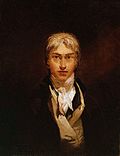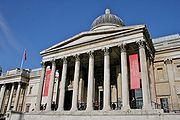
File:Rain Steam and Speed the Great Western Railway.jpg

| |
This is a file from the Wikimedia Commons. Information from its description page there is shown below.
Commons is a freely licensed media file repository. You can help. |
Summary
| Artist |
|
|||||||||||||||||||||||
| Title | Rain, Steam and Speed - The Great Western Railway; the painting depicts an early locomotive of the Great Western Railway crossing the River Thames on Brunel's recently completed Maidenhead Railway Bridge.The painting is also credited for allowing a glimpse of the Romantic strife within Turner and his contemporaries over the issue of the technological advancement during the Industrial Revolution (see below). | |||||||||||||||||||||||
| Date | 1844 | |||||||||||||||||||||||
| Medium | oil on canvas | |||||||||||||||||||||||
| Dimensions | 91 × 121.8 cm (35.8 × 48 in) | |||||||||||||||||||||||
| Current location |
|
|||||||||||||||||||||||
| room 34 | ||||||||||||||||||||||||
| Credit line | Turner Bequest, 1856 | |||||||||||||||||||||||
| Source/Photographer | http://www.nationalgallery.org.uk/paintings/joseph-mallord-william-turner-rain-steam-and-speed-the-great-western-railway | |||||||||||||||||||||||
| Permission ( Reusing this file) |
See below. | |||||||||||||||||||||||
Social Commentary
Turner was a well traveled man, frequently trekking to natural wonders of mainland Europe and the British Isles to sketch them in one of his dozens of notepads. He knew of the pains one must take to travel off the beaten path and wrote of one such occasion, traveling from Rome to Paris, to a friend in 1829:
“…we never could keep warm or make our day’s distance good, the places we put up at proved all bad till Firenzola being even the worst for the down diligence people had devoured everything eatable (Beds none)…crossed Mont Cenis on a sledge – bivouaced in the snow with fire lighted for 3 Hours on Mont Tarate while the diligence was righted and dug out, for a Bank of Snow saved it from upsetting – and in the walk up to our knees in new fallen drift to get assistance to dig a channel thro’ it for the coach, so that from Foligno to within 20 miles of Paris I never saw the road but snow!”1
Fifteen years later, Turner’s 1844 masterpiece, Rain, Steam and Speed: The Great Western Railway, in a way recognizes his thrill in the speed of the new coal train and his appreciation for such technology when traveling. Yet, he subtly recognizes the progressive threat that humans pose towards the cradle of the earth.
The title follows the Turner pattern of 'nature first' in his titles, but at once you see what looks like a monstrous kiln underneath the rail bridge, and flames engulfing the ecstatic figures on the far side of the river. On top of the bridge you see the face of a demon with the body of a coal burning centipede, which itself looks like a line of glowing embers. Ahead of the train it is hard to spot the tiny hare at full sprint, trying to stay ahead of the state-of-the-art technology of the mid-1800’s. What is so interesting about this piece, Olivier Meslay points out in his book JMW Turner: The Man Who Set Painting on Fire, is that “the notion of the sublime was no longer confined to natural phenomena, but incarnated in machines created by humanity with god-like aspirations, whose new power it served to magnify” and begs to question; what should we fear more, the awe of the wild, or the annihilation of it?2
1. Meslay, Olivier. JMW Turner: The Man Who Set Painting On Fire. London: Thames & Hudson Ltd, 2005. Pg 133
2. Ibid. Pg 107
Licensing
The official position taken by the Wikimedia Foundation is that "faithful reproductions of two-dimensional public domain works of art are public domain, and that claims to the contrary represent an assault on the very concept of a public domain". For details, see Commons:When to use the PD-Art tag. |
|||||
File usage
Metadata
| JPEG file comment | LEAD Technologies Inc. V1.01 |
|---|
Want to know more?
This selection has made Wikipedia available to all children. SOS Childrens Villages helps those who have nothing and no one, giving them back the famly they have lost and bringing them the very best opportunities for a happy, healthy future. You can help by sponsoring a child.




